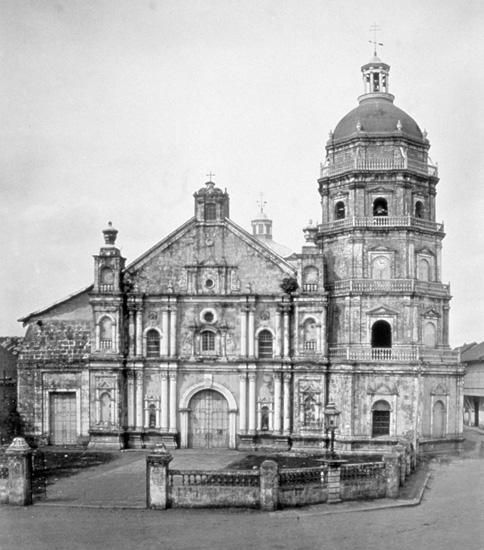Share this page:
Binondo Church (also known as the Minor Basilica and National Shrine of St. Lorenzo Ruiz) is located in Manila's Chinatown district.
You will find it at the corner of Ongpin Street and Quintin Paredo Road and at the edge of the Plaza San Lorenzo Ruiz in Binondo, Manila.
The architectural style is Spanish or European Baroque and moreover it is notable for its octagonal five-tier Chinese-style bell tower which reflects the culture and art of the surround Chinatown.
Binondo Church over the Centuries
This church was founded by Dominican priests in 1596 to serve their Chinese Christian converts in the Binondo area where the Spanish authorities permitted Chinese and Chinese mestizos to live. The church also served native Filipino Christians.
The original design of this church came from the talented Spanish architect, Domingo de la Cruz González.
According to the background notes for the Manila 1571-1898, The West in East exhibition (Madrid, 1998):
"[i]ts façade was characteristic of those to be seen in Manila, as was that of the monastery church of San Francisco which no longer exists. Typical elements are lateral towers, trapezium-shaped gable ends topped with a vaulted niche, small octagonal-shaped windows and twin columns.
Binondo Church suffered damage again and again from earthquakes and wars over the centuries. Of the original church built according to Domingo de la Cruz González's design, only the Chinese-style octagonal bell tower has survived to this day.
The original building was destroyed by a bombardment by the British in 1762 during their brief occupation of Manila at that time.
The Binondo Church was rebuilt and restored on the same site in 1852.
The church was destroyed once again in the earthquake of 3 July 1863 (that also flattened a great many buildings - including Manila Cathedral, the City Hall and the Governor's Palace - in nearby Intramuros).
According to Natural Disasters by Lee Allyn Davis (Infobase Publishing, 2008, p. 85): "Two shocks, each of a minute's duration, toppled the Binondo Church and the huge Church of St. Domingo. (...) At the Binondo Cathedral, seven priests remained unscathed by huddling underneath a gothic arch, which held; hundreds of others, worshipping beneath its dome, were crushed when the dome fell."

Binondo Church in the latter part of the 19th century. It shows the Church as it was reconstucted after the earthquake of 1863
In 1893 or 1894 Andrés Bonifacio (the Filipino nationalist and revolutionary, who is often referred to the "Father of the Philippine Revolution") married Gregoria de Jesús in the Binondo Church.
In September 1944 Binondo Church was greatly damaged by U.S. Air Force bombing. Only its stone walls, western facade and Chinese style bell tower survived. The archives of the Binondo parish, with all their irreplaceable historical documents, were unfortunately destroyed.
A new roof was put in place in the 1950s and the church was renovated in the period from the end of the war until 1984. A parish center and a convent were added at the rear of the church. The church interior was rebuilt with marble and gilt reredos (screens or decorations behind a church altar).
San Lorenzo Ruiz, the First Filipino Saint
As noted above, the Binondo Church is also known as the Minor Basilica of San Lorenzo Ruiz. It was named after the sacristan, San Lorenzo Ruiz (c. 1600 - 1637), who was born of a Chinese father and a Filipino mother, trained in this church and afterwards went as a missionary to Japan and was executed there for refusing to renounce his religion.
San Lorenzo Ruiz was to be the Philippines' first saint: he was beatified in 1981 and he was canonized in 1987. A large statue of the martyr stands in front of the church and since 1981 the square in front of the church has also been named after him (Plaza San Lorenzo Ruiz).
Binondo Church today
Masses are held in Filipino (that is, Filipino), in the main Chinese dialects spoken in the Binondo area (Mandarin, Hokkien), and in English.
Further Reading
http://www.orientalarchitecture.com/philippines/manila/binondo.php
http://www.aenet.org/manila-expo/page16.htm
http://jeepneymanilaph.wordpress.com/2013/03/10/binondo-church-minor-basilica-of-st-lorenzo-ruiz/
http://tanawin.wordpress.com/2008/10/03/then-and-now-binondo-church-part-1-of-2/
Philippine architecture during the pre-Spanish and Spanish periods
(by Norma Ipac-Alarcon)
(Santo Tomas University Press, 1991)
Three centuries of Binondo architecture, 1594:1898: a socio-historical perspective
(by Lorelei D. C. De Viana)
(University of Santo Tomas Publishing House, 2001)
A Tourist Guide to Notable Philippine Churches
(by Benjamin Locsin Layug).
(Pasig City, Philippines, New Day Publishers, 2007)
Share this page:
Author: David Paul Wagner
(David Paul Wagner on Google+)